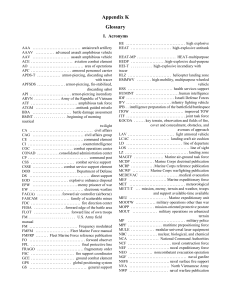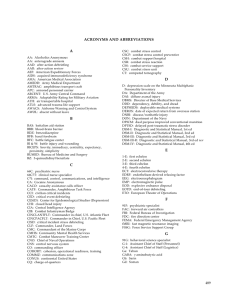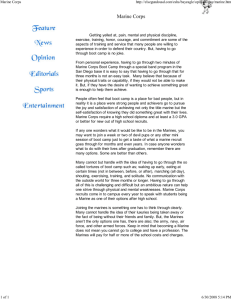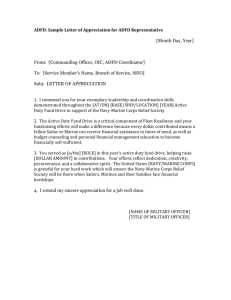NOT FOR PUBLICATION UNTIL RELEASED BY THE SENATE ARMED SERVICES COMMITTEE
advertisement
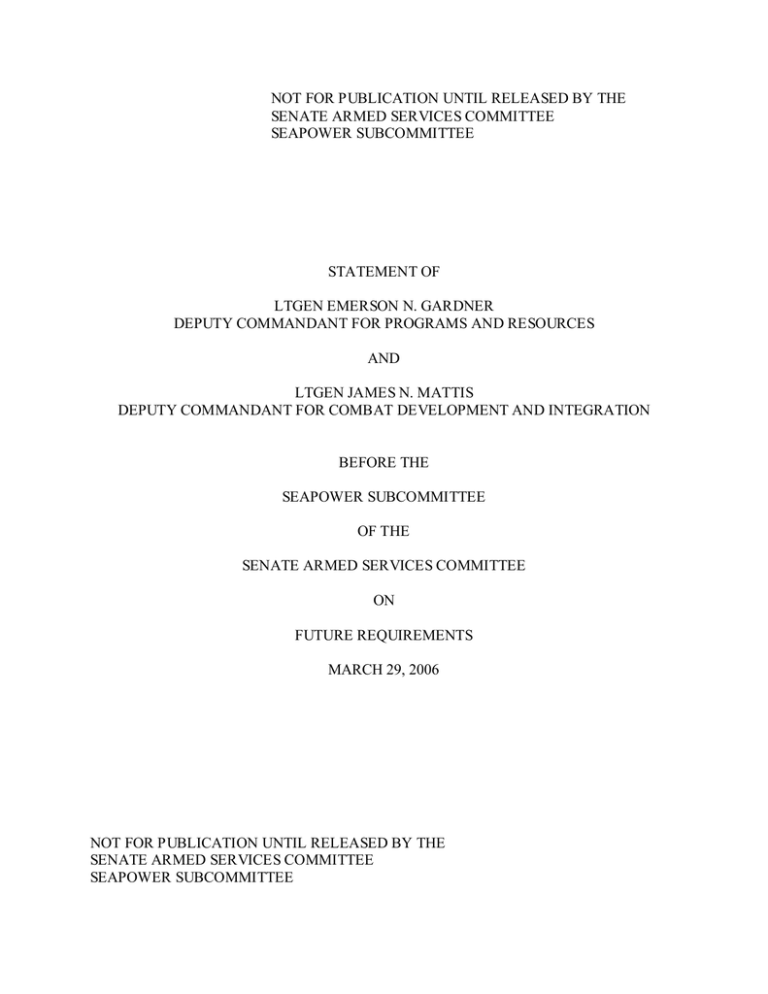
NOT FOR PUBLICATION UNTIL RELEASED BY THE SENATE ARMED SERVICES COMMITTEE SEAPOWER SUBCOMMITTEE STATEMENT OF LTGEN EMERSON N. GARDNER DEPUTY COMMANDANT FOR PROGRAMS AND RESOURCES AND LTGEN JAMES N. MATTIS DEPUTY COMMANDANT FOR COMBAT DEVELOPMENT AND INTEGRATION BEFORE THE SEAPOWER SUBCOMMITTEE OF THE SENATE ARMED SERVICES COMMITTEE ON FUTURE REQUIREMENTS MARCH 29, 2006 NOT FOR PUBLICATION UNTIL RELEASED BY THE SENATE ARMED SERVICES COMMITTEE SEAPOWER SUBCOMMITTEE Chairman Talent, Senator Kennedy, distinguished members of the Subcommittee, thank you for the opportunity to appear before you to discuss Marine Corps maritime and aviation requirements. Your Marine Corps is entering the fifth year of what has been aptly termed The Long War and because of the support received from Congress, Marines continue to demonstrate that they are an expeditionary force in readiness – Most Ready When the Nation is Least Ready. Scalable, flexible and adaptable for peacetime crises and always innovative for future challenges, your Corps’ number one priority is fighting and winning battles. On behalf of all Marines, we thank the Committee for your continued support and commitment to the readiness of your Marine Corps. Creating Stability in an Unstable World We remain the Nation’s premier expeditionary combat force-in-readiness. We are primarily a Naval force whose strength is our ability to access denied areas from great distances. We project Marine forces from land or sea bases for operations as part of a joint or combined force. We provide defense of the homeland by operating from forward deployed locations throughout the world. We sustain our deployed forces for extended periods of time. We fight across the spectrum of conflict. However, we believe that our future will be characterized by irregular wars. The enemy we are fighting today is different than those in our recent past. He is a transnational actor with no allegiance to sovereign nations or respect for conventional rules of war. To address this threat, we focus on warfighting excellence in everything we do. A guiding principle of our Corps is that we fight as combined-arms teams, seamlessly integrating our ground, aviation and logistics forces adapted to the complexities of irregular war. We exploit the speed, flexibility, and agility inherent in our combined-arms approach to defeat irregular, traditional, and emerging threats to our Nation’s security. Every Marine is a rifleman and a warrior—our link to the past and a highly relevant key to the future. We train and educate our Marines to think independently and act maturely and aggressively, with speed and initiative, and to exploit the advantages of cultural understanding. We thrive in the chaotic and unpredictable environments in which our forces are employed. We are committed to providing relevant, sustainable and sturdy forces to the joint task force commanders. Marines are intensely devoted to each other and the defense of our Nation. 2 Quadrennial Defense Review (QDR) The 2006 QDR report highlights that seabasing and flexible options for expeditionary maneuver are not only relevant, they are critical to our strategic goals. The QDR defines achieving global freedom of action as one of the four key objectives in the National Defense Strategy. To increase our Nation’s freedom of action, we need to focus on the following four areas: operational readiness; global reach; building partnership capacity; and strengthening alliances. Seabasing plays a significant role in all four of these areas, but makes its greatest contributions in enhancing global reach. The QDR specifically calls for more flexible basing and indirect operational approaches. With its characterization of today’s security environment as an era of uncertainty and surprise, marked by a shift from static defense and garrison forces to mobile expeditionary operations, the QDR suggests more emphasis be placed on agility of response rather than speed of response. It seeks tailored deterrence by shifting from responding after a crisis starts (reactive) to preventive action so that problems do not become crises (proactive). This requires an agile and integrated joint force that is more rapidly deployable and more capable against a wider range of threats. Lastly, the QDR highlights the need to develop the capability “to deploy rapidly, assemble, command, project, reconstitute, and re-employ joint combat power from all domains to facilitate assured access.” If we as a nation desire to assure we can gain access at a time and place of our choosing, it is imperative that we continue to invest in and further advance our Nation’s seabasing capabilities to achieve global freedom of action. There is no better way to reassure our friends around the world while confronting our enemies with a compelling threat. Seabasing – A National Capability America’s ability to use international seas and waterways, as both maneuver space and an operating base unconstrained by foreign veto, allows our naval forces to project combat power into the littoral regions. The littorals contain more than half the world’s population and more than 75 percent of its major urban areas. Highly mobile and ready for combat, our forwarddeployed expeditionary forces are critical instruments of U.S. diplomacy and central components of joint military force packages designed to quickly contain a crisis or defeat an emerging threat. The Navy and Marine Corps Team can project unmatched amphibious forcible-entry capabilities and provide a persistent combat capability from a mobile sea base, thus reducing the U.S. 3 logistical “footprint” ashore. By exploiting our nation’s premier asymmetric advantage— command of the sea—the Navy and Marine Corps can loiter over the horizon and project, protect, and sustain integrated joint warfighting capabilities, provide muscular yet agile support for the Commander in Chief’s diplomatic efforts, and ensure operational independence for Combatant Commanders across the full spectrum of warfare. Today and tomorrow, a most visible element of assurance to allies and deterrence to foes will be naval forward presence, including capabilities of Marine Expeditionary Units (Special Operations Capable) (MEU(SOC)) embarked, protected, and sustained by Expeditionary Strike Group (ESG) ships. These units provide the Combatant Commanders with forwarddeployed adaptive units that can conduct a variety of quick reaction, sea-based, crisisresponse options against traditional challenges or against irregular foes. To appreciate our Nation’s ability to maintain global presence, we only need to reflect back 23 years. From Beirut to Biloxi, our Nation has responded with amphibious forces to 76 global events ranging from humanitarian relief to combat operations, each of which provides an excellent example of our current capabilities. The current force-sizing construct requires the capability to respond to two (2) swiftly defeat the efforts (SDTE) – each of which requiring a Marine Expeditionary Brigade (MEB) size force. One of these crises may become a Decisively defeat Campaign, bringing our most powerful force to bear, the Marine Expeditionary Force (MEF), for highly capable, lethal mobile and sustained operations. This requires 30 operational available amphibious warships (10 of which must be large deck amphibious ships capable of supporting the aviation combat element of the assault echelon). The future Seabasing effort will allow more efficiency in the generation of our Expeditionary Brigades, enabling the forces to flow direct from home bases to the forward, onscene, Seabasing ships, while leveraging the Sea Shield force protection for off-shore, less vulnerable operating bases. As a crisis builds, 1-2 forward deployed MEUs serve as the “leading edge” of the MEB, conducting advanced force and limited objective, initial entry/response 4 efforts, while the remainder of the strike power of the MEB is assembled on scene as part of the MPF(F) Seabasing echelon. As “proof of concept,” our Nation’s strength and capability to operate in an anti-access environment was tested during Operation Enduring Freedom (OEF). The war against the Taliban and Al-Qaeda in Afghanistan provided a harsh dose of reality for those who assumed traditional threats and the availability of friendly, convenient land bases to project airpower and land forces. In the early phases of OEF, two forward-deployed Marine Expeditionary Units and associated amphibious shipping formed Task Force 58 and projected the first major U.S. “conventional” combat units into Afghanistan – more than 350 miles from its sea base of amphibious shipping. Yet, their operations were far from traditional or conventional in tone. We believe recent experiences, such as Turkey’s prohibition of passage for the 4th Infantry Division to open a northern front in the early stages of Operation Iraqi Freedom (OIF), are compelling insights for how operations must be conducted in the future. When negotiating for the 4th Infantry Division to transit Turkey, the U.S. offered to pay a multi-billion dollar option for a one time passage when this funding could have been applied to our Nation’s future warfighting investments such as MPF(F). In the globalized world and information age, “all politics are local” remains a constant theme but now has strategic implications. Our naval forces, operations off-shore, are more relevant now than ever before, when even friendly nations may deny U.S. forces land basing and transit due to their own sovereign interests. Distributed Operations. The attributes of sea power are extremely useful to the Combatant Commanders. However, this operational capability must also be matched by increased tactical capabilities that enhance the effectiveness of our "boots on ground" to enable operational maneuver and to create stability, especially in irregular and counter-insurgency operations where decisive combat has shifted to ground combat against irregular forces. After a quarter century of unwavering commitment to our maneuver warfare philosophy, Marines are harvesting a generation of junior officers and noncommissioned officers who are better prepared to assume much greater authority and responsibility than traditionally expected at the small-unit level. As an additive tactic and 5 complementary capability to our Seabasing concept, Distributed Operations describes an operating approach that will create an advantage over an adversary through the deliberate use of wider dispersion and coordinated, interdependent, tactical actions enabled by enhanced communications, increased access to joint fire support, as well as by enhanced combat capabilities at the small-unit level. The essence of this concept lies in enhanced small units gained through taking advantage of our high quality, combat experienced Marines and the incorporation of emerging technologies which will support them. Once implemented, a networked Marine Air-Ground Task Force operating in a Distributed Operations manner will disperse, mass, and disperse again to exploit opportunities the enemy offers. The integration of new doctrine, force structure, training, equipment, personnel policies and leader development initiatives will afford our tactical and operational commanders a significantly enhanced weapon in the increasingly sophisticated Global War on Terror. Marine Corps Maritime Lift & Naval Surface Fires Requirements In order to support Joint Forcible Entry Operations (JFEO), the Marine Corps shipbuilding requirement is two amphibious MEB Assault Echelons (AE) plus two Maritime Preposition Force (Future) (MPF(F)) MEBs (or equivalent as indicated below). ¾ 30 operationally available amphibious ships, of which 10 must be operationally available big-deck aviation-capable ships to support two MEB AE. • Note: operationally available – minimum amount of ships required to conduct the mission. Planning factors will account for ship maintenance cycles. • Minimum of 9 LPD-17s within the LPD program to mitigate risk incurred by limiting each MEB AE to 15 amphibious ships. - Both Discrete and Volumetric analysis have been conducted to load the “2015 MEB AE” on amphibious ships. 17 ships (five LHD, five LPD-17, five LSD-41, two LSD-49) are required, however, the Marine Corps has accepted risk with a 7% reduction in MEB equipment by self limiting to 15 ships per MEB AE. - Limiting the LPD-17 production line to 9 ships places the Marine Corps at grave/significant risk by further decrementing the MEB equipment for the assault echelon. ¾ 2 MPF(F) MEB squadrons or one MPF(F) squadron plus two legacy Maritime Preposition Ship (MPS) squadrons. • MPF(F) squadron will consist of 14 ships with two types using proven amphibious hull designs: one LHD, two LHA(R), three T-AKE, 6 three LMSR, three Mobile Landing Platform ships, and two legacy “dense-pack” maritime prepositioning ships. • We are not ready to commit MPF(F) to forcible entry in the assault echelon without further experimentation in the following areas: - Civilians (Merchant Marines) manning MPF(F) and associated legal implications. - Survivability, preposition loading, and continued on-load / off-load experiments, etc. ¾ Naval Surface Fire Support (NSFS) that meets the Marine Corps requirement of “24/7,” all weather, long range naval surface fires in support of amphibious operations from the sea with continuous striking power and volume of fires out to a range of 63 nautical miles (Threshold) to 110 nautical miles (Objective) from ships at sea. ¾ LHA/LHD recapitalization plan. ¾ Recapitalization plan for LSD line to bridge from last LPD to first LSD replacement (must account for LHA(R) design of not having a well deck). Marine Corps Aviation Requirements Fixed Wing Rotary Wing 360 MV-22 420 F-35B (JSF) 156 CH-53K 51 C-130J 180 AH-1Z 100 UH-1Y UAS Tier III Initial Capabilities Document (ICD) for VUAS approved by the Joint Requirements Oversight Council (JROC) Dec 05. Planning for 11 systems (4 air vehicles per sys) ¾ We have lost a total of 27 aircraft in support of OIF/OEF/HOA operations. Until last Fall (28 Sep 05 - MV-22 full rate production decision), we have not had a “hot” manufacturing line from which to replace these losses because we are in the midst of recapitalizing our legacy fleet. ¾ With only one active production line for our existing rotary-wing aircraft, addressing near-term inventory shortfalls for this generational war requires revisiting the production ramp-up rates for the procurement of the MV-22, KC-130J (procure multi-year), H1Y/Z aircraft and staying on track with the development of the CH53K. ¾ F-35B (JSF) – preserve Initial Operational Capability (IOC) date of FY-12 in order to replace legacy aircraft operating beyond the Expected Service Life (ESL). Fiscal Year 2007 and Future Years Defense Programs--Modernization and Transformation While we continue to focus our efforts on sustaining the current requirements for Global War on Terror, we must not sacrifice our modernization and transformation initiatives in the process. Our modernization and transformation accounts can no longer bear the unfunded costs associated with sustaining the Global War on Terror, which is why the Administration is 7 requesting funds in the Fiscal Year 2006 Supplemental to continue addressing the resetting of our forces. Our modernization and transformation initiatives must plan for the procurement of replacement equipment that will enable our Corps to be ready for future conflicts and contingencies. The readiness of our Corps remains dependent on our ability to continue to attract and enlist young men and women dedicated to the preservation of freedom and to service to our great Nation. We will continue to inspire, train, and equip them for success. Our Fiscal Year 2007 budget and our Fiscal Year 2006 Supplemental request work together to address our essential operational and maintenance requirements to sustain our readiness, while providing opportunity for investment in the resetting and continued modernization of our Corps. We will dedicate these resources to the destruction of our enemies and stability for our friends and thank you for this support. Your unwavering support is deeply appreciated. Specific responses to the Subcommittee’s request for information For the purpose of this statement, we have emphasized Marine Corps maritime lift, Naval Surface Fires Support, and aviation requirements. Additionally, we have provided Enclosure (1) for the responses to the Subcommittee’s specific request for information. Conclusion Your Marines are fully dedicated to serving and protecting this Nation. Their bravery, sacrifice, and commitment to warfighting excellence are well known to you. We recognize we have an essential mission, and that we have the solid backing of the American people. The Marine Corps fully understands that our greatest contribution to the Nation is our high-level of readiness across the spectrum of conflict. We see Seabasing as a National Capability that Regional Combatant Commanders can immediately apply to emerging threats transcending all levels of warfare. No longer will we need to rely on critical airfields and seaports in the initial phases of conflict. On behalf of all Marines, we thank the Committee for your continued support that has made us more effective in the fight, saved lives, and will allow us to protect this great Nation in an uncertain future. 8



